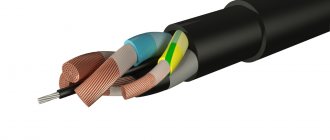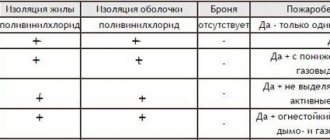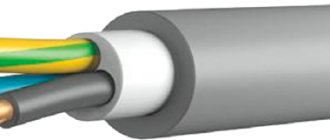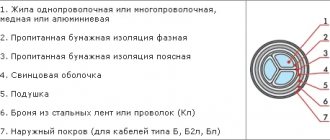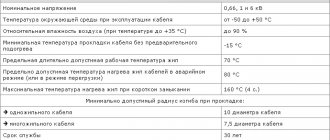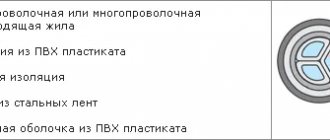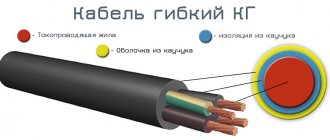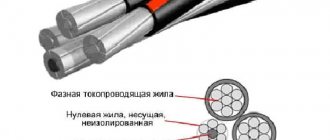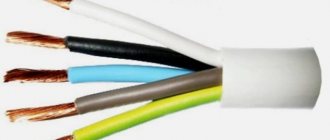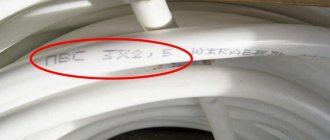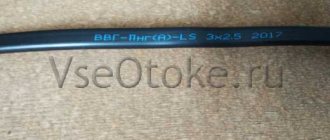Explanation of the TPPep marking
To determine the main parameters of the TPPep cable, consider its markings. The marking includes alphabetic and numerical designations indicating the scope of application and other characteristics, namely:
- T - indicates that this is a telephone cable designed to transmit communication signals;
- P – cable cores are insulated with polyethylene;
- P – denotes the material of the outer shell of the insulating layer – polyethylene;
- ep - indicates the presence of a film-type screen; in cases where this letter designation is absent, the cable is equipped with a foil screen, but such models are no longer produced, but are in use.
In addition to the above standard markings for TPPep, additional ones can be used. For example, if there is the letter “Z” - TPPepZ, such marking will mean that it has a hydrophobic filling, oil or other based on fatty compounds, which prevents the accumulation of moisture. The letter “B” - TPPepB indicates the presence of armor around the main cable sheath, usually made of tin tape. The presence of the letter “M” in front of the TPP - MTPP indicates that the model has few pairs - the number of pairs in it is from 1 to 5, and the prefix “ep” may also be absent - then the wire does not contain a screen.
Consider an example of decoding the cable marking TPPepZB - 100 × 2 × 0.64. Accordingly, here is a telephone cable with polyethylene core insulation and polyethylene sheath insulation, a film screen, filled with a hydrophobic substance with an armor coating. 100×2 - indicates that the cable uses 100 working pairs, but in practice there are slightly more of them - 102, 103 or 105, the rest are used as spare ones. Spare conductors are included in models of 50 pairs or more. 0.64 is the diameter of the conductor, in this case it is 0.64 mm.
Sections
Cable VBBShv
Serial cable TPP is produced with cores with a diameter (mm): 0.32; 0.4; 0.5; 0.64; 0.7 and 0.9. If necessary, using the well-known geometric formula (S= (π*d2)/4), you can calculate the cross-sectional area. For d=0.64, the value is S = (3.14+0.642)/4 = 0.8874 mm2. When multiplied by the number of conductors, the total cable cross-section is specified.
The following parameters are encrypted in the digital part of the type designation (50 x 2 x 0.64):
- 50 – number of pairs;
- 2 – pair arrangement of conductors;
- 0.64 – diameter of the conductor in mm.
Using these values in the reference table, you can determine the corresponding outer diameter of the product - 22.8 mm.
Design
The TPPep cable is a device for transmitting low-power electrical signals and structurally includes such elements.
Rice. 1.: TPPep cable design
As shown in the figure, structurally it consists of:
- 1 - the main rod of current-carrying conductors, consisting of conductors connected in pairs. Copper is used as a conductor material. The diameter of such a core can be from 0.32 to 0.9 mm, and their number and type of twist determine the numbering order and method of connection in the cable. In total, there are two types of twisting for TPPep - ply and bunch.
- 2 - core insulation made of polyethylene. It has different colors, allowing you to easily distinguish between wires in pairs. This difference helps to quickly navigate when routing wires in the coupling.
- 3 – a screen made of aluminum-polyethylene tape, designed to remove electromagnetic interference induced from outside. Additionally, a conductor is installed with it to remove the induced potential.
- 4 – bare tinned copper wire, intended for connecting the screen, allows you to remove the induced potential from the shielding surface.
- 5 – outer shell – designed to protect the main core of the TPPep from external factors. Made from light-stabilized polyethylene.
Stranding type
As stated above, the TPPep cable can have two types of twisting - twisted and bunched. At the moment, the beam type TPPep is being produced, but both are still widely used in operation. Therefore, take a closer look at the differences between both types.
Stranded TPPep - implies an arrangement of pairs in the cable in which the wires in it form several layers. These layers are called layers, which is where the name of the type of twist comes from.
Rice. 2. Strand design
A distinctive feature of this TPPep cable design is the bright markings of the first and second pairs - red and blue, respectively. The direction of counting - clockwise or counterclockwise - depends on their location. The remaining strands are not distinguished by their bright color, but each layer is separated from the previous one by a thread twist that holds each of them separately. Therefore, by unraveling one of the layers, the rest remain assembled and do not create confusion when connecting.
But, due to the lack of color marking of the cores, the process of identifying the required pairs when connecting becomes much more complicated, so they have to be called. A significant advantage over TPPep bundle twisting is its much smaller outer dimensions.
Bundle twisting is an arrangement of cores in a cable when several pairs (5 or 10, depending on the total number in the rod) are combined into one common bundle.
Rice. 3. Bundle twist design
A distinctive feature of the bundle-type TPPep cable is that each bundle is separated using a wound thread, which secures the pairs in it and prevents them from breaking up. This braid includes a colored thread or tape indicator, which allows you to highlight a specific group of conductors. But it should be noted that there are TPPep brands that contain several bundles with the same color. In such situations, you cannot navigate by color marking when connecting; you should definitely call the wires.
Analogue substitutes for telephone cable TPPep
Products with a relatively small number of pairs (1-5) are marked with the letter “M” in the abbreviation – MTTPep. Modifications of KAPZ are created according to a similar standard design, but some products in this series are created with the diameter of conductors increased to 1.2 mm (corresponding to an increase in cross-section). The combination “KA” means “subscriber cable”.
Experts suggest using the following replacements if necessary:
- PKSV - cable with single-wire copper conductors, designed for a constant voltage of no more than 120V and a signal frequency of 100 MHz maximum;
- TSV, TPV, TRV - analogues with copper conductors with different types of shells;
- TZASHP - improved multi-layer protective covers, 4-19 twisted “fours”;
- MKEKSHV is an effective screen made of thin copper wires.
For your information. Modifications with low smoke emission and non-combustion are designated LS and NG, respectively. In some situations, the installation of such products is required by the mandatory requirements of fire safety regulations.
Specifications
If connected to any circuits, it is important to ensure that the characteristics of the TPPep cable correspond to the operating parameters of the device or its networks.
The main technical characteristics include:
- The rated operating voltage is 225 and 145 V for AC lines, and 315 or 200 V for DC sections.
- The permissible operating temperature limit ranges from -50 to +60°C for the TPPep brand.
- Resistance to electric current - determines the ability of the cable to conduct electricity; for TPPep it varies from 216 to 27.4 Ohm/km when direct current flows.
- Capacitance is especially important in determining the impedance in alternating voltage circuits and is 45 nF/km.
- Insulation resistance is measured with a megohmmeter and is at least 6500 MOhm.
- The minimum bending radius must be at least 10 outer diameters of the TPPep. Determined depending on the number of pairs in a particular model, this value can be taken from the table.
Table: Estimated outer diameter of cable, mm
| Number of pairs of wires in the cable | Core diameter | |||||
| 0.32 mm | 0.40 mm | 0.50 mm | 0.64 mm | 0.70 mm | 0.90 mm | |
| 5 | 6,5 | 7,1 | 7,9 | 9,0 | 9,7 | 11,4 |
| 10 | 7,7 | 8,4 | 9,6 | 11,5 | 12,5 | 15,5 |
| 20 | 9,5 | 10,6 | 12,3 | 15,4 | 16,8 | 21,2 |
| 30 | 11,2 | 12,4 | 15,1 | 17,6 | 20,2 | 24,4 |
| 50 | 14,2 | 15,6 | 18,5 | 22,8 | 24,9 | 31,3 |
| 100 | 17,6 | 21,3 | 26,1 | 30,7 | 33,7 | 42,3 |
| 200 | 24,4 | 28,6 | 34,0 | 41,4 | 45,7 | 57,4 |
| 300 | 29,5 | 33,4 | 41,0 | 49,9 | ||
| 400 | 32,9 | 38,5 | 46,1 | 56,2 | ||
| 500 | 35,9 | 42,1 | 51,6 | 62,1 | ||
| 600 | 39,7 | 45,3 | 55,6 | 67,2 | ||
| 700 | 42,3 | 49,3 | 59,7 | |||
| 800 | 44,6 | 52,1 | 63,2 | |||
| 900 | 46,8 | 54,7 | 66,4 | |||
| 1000 | 49,9 | 57,1 | 69,5 | |||
| 1200 | 53,8 | 62,1 | 75,3 | |||
| 1400 | 57,4 | |||||
| 1600 | 61,6 | 70,2 | ||||
| 1800 | 64,7 | 73,9 | ||||
| 2000 | 67,7 | |||||
| 2400 | ||||||
Basic principles of operation
A modern telephone cable of the described type is a twisted pair of wires (cores). Their total quantity is written on the product and must be taken into account when deciding which product to purchase.
This method of producing wires is due to the fact that each conductor in a pair transmits a signal in the opposite direction, which makes it possible, for example, to talk on the phone at the same time (not only to hear the voice of the interlocutor, but also to speak). Each twisted pair is connected to a device that provides transmission and reception of a signal that is transmitted along the conductor in the form of voltage fluctuations. At the moment of information transmission, the voltage is at its maximum; this pulse passes through the conductor and reaches the receiver, which detects the increase in voltage. Then, with the help of special converters, the signal is converted into voice, text, characters on the screen, and so on.
Signal transmission via wire
When operating the described electrical products, it should be taken into account that if the signal source is significantly removed from the receiver, significant interference may occur. Signal distortion also occurs in the case of weak insulation of twisted pairs in the conductor. The existing electromagnetic fields in each of them influence each other, which leads to interference and deterioration in the quality of transmitted information.
This can be avoided if you adhere to a number of basic rules when installing the network:
- The communication line route must be designed in such a way that the distance between its nodes is always the shortest possible;
- It is desirable that the number of pairs in the cable does not exceed four;
Additional Information. However, in some cases, laying such a wire is not economically feasible. In such a situation, you should either use cables with an internal shield that prevents the spread of interference, or install special adapters throughout the network that neutralize interference.
- When designing a communication line route, it is recommended to avoid placing it near sources of increased electromagnetic radiation (power lines, power plants, large enterprises, and so on).
How to avoid signal transmission interference?
So, the described electrical products are used, as a rule, for laying low-current lines to provide telephone communications, installation of video surveillance and control systems, and so on. Depending on the operating conditions, the appropriate cable should be selected. Otherwise, it may quickly fail. In addition, to ensure high-quality signal transmission, it is recommended to follow certain rules to minimize interference.
Advantages and disadvantages
In comparison with other models of cable and wire products used in communication lines, this brand has a number of advantages and disadvantages. The advantages of the TPPep cable include:
- The presence of bundles or layers fastened together that do not fall apart during installation.
- Using the TPPep color marking system, which greatly simplifies the process of connecting cable leads to a coupling or terminal block.
Figure 4. Example of connecting cable pairs - The presence of a shielding coating that significantly reduces the amount of interference from external electromagnetic waves.
- A wide range of models allows you to transmit signals for any number of subscribers or signal transmission points.
- Resistance to moisture, in comparison with communication cables with a vinyl sheath, are much less susceptible to the accumulation of moisture from the environment. Due to this, the scope of their application is significantly expanded.
Among the disadvantages of the TPPep cable, one should highlight its greater susceptibility to combustion when exposed to flame. As practice has shown, the polyethylene shell ignites easily and supports the development of fire. Another disadvantage of TPPep is that some models with a large number of beams have the same color marking. This negates the ability to connect based only on coloring.
Lifetime
Under the conditions stipulated by the design calculations, the tppep cable retains good technical characteristics for 20 years and more (25-armored modifications). Compliance with the actual operating conditions of a particular design is essential. Thus, when installing outdoors, it is recommended to choose shells that are resistant to ultraviolet radiation. Steel tapes will prevent mechanical damage. These observations explain the economic feasibility of increasing the initial investment to extend the life of wired information transmission channels.
Application
The TPPep cable is used to form communication lines or to transmit any control signals. This brand of cable is laid in telephone sewerage devices, on walls, in shafts, trays, overhead lines and in cable ducts. It should be noted that at the initial stages of production of TPPep it was also used for underground installation in the ground, but the cable very quickly failed due to the active influence of the environment. Since its placement in open ground is not currently used, any other negative effects on the insulation during operation should also be avoided.
The TPPep cable can only be used in areas and places where there is no significant electromagnetic influence. Otherwise, the level of interference will affect the transmitted signals.
Areas of use
Cable ААШВ
Cable products of this category were previously used to create underground communication lines in the ground. Currently, such solutions are not used due to the relatively short service life of TPPep in difficult conditions. Acceptable installation:
- using specialized sewerage protected by concrete walls;
- in metal mounting trays;
- in grooves and channels;
- in an open version for fastening to walls;
- with hanging systems indoors and outdoors.
Main manufacturers
When choosing a specific TPPep brand, you should pay special attention to the leading manufacturers of this type of product. Since they are the ones who ensure proper quality and compliance with all declared characteristics. Among these companies, the following have proven themselves well:
- Samara Cable;
- "TD RT-Cable";
- "TD Voronezhtelekabel"
The above companies produce TPPep in a wide variety of sizes and modifications. Therefore, before purchasing a specific model, you should decide on the parameters you need and choose the most suitable one from those offered in the catalog.
